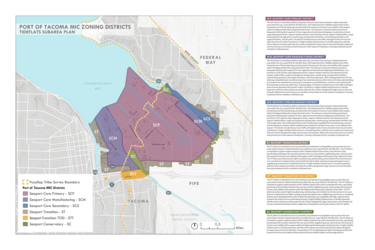Tideflats Subarea Plan
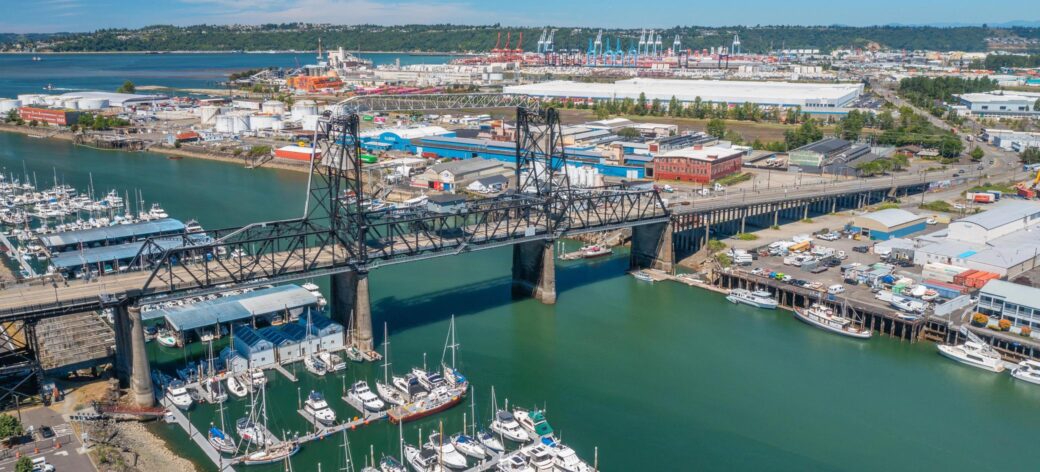
Contact
Stephen Atkinson
Principal Planner
SAtkinson@tacoma.gov
City Council – First Reading of Ordinances
On November 12, 2025, the Tacoma City Council conducted the first reading of ordinances related to the Tideflats Subarea Plan and proposed amendments to the One Tacoma Comprehensive Plan, Tacoma Municipal Code Title 13 – Land Use Regulatory Code, and Title 19 – Shoreline Master Program.
Final reading of these ordinances is tentatively scheduled for December 2, 2025.
City Council Public Hearing
The City Council held a public hearing on October 28, 2025, to receive public input on the Draft Tideflats Subarea Plan and proposed amendments.
Exhibits for Public Review:
- Tideflats Subarea Plan (as recommended by the Steering Committee)
- Amendments to the One Tacoma Comprehensive Plan
- Amendments to TMC Title 13 Land Use Regulatory Code
- Amendments to TMC Title 19 Shoreline Master Program
-
What recent changes did the City Council make?
On September 9, the City Council officially opened the latest draft of the Tideflats plan for public review and comment. Before they did, they made several edits to the proposed rules for land use and shorelines. These changes were based on recommendations from the Planning Commission and feedback they’d already received from the public. Now, the Council wants to hear what you think about these specific new changes.
What laws guide the creation of this plan?
A City plan can’t be created in a vacuum; it has to follow existing state and regional laws. For the Tideflats, the main rules we must follow are:
- Growth Management Act (GMA): The state’s primary law for planning how communities grow
- Shoreline Management Act (SMA): Provides special rules for protecting and developing areas along the water
- State Environmental Policy Act (SEPA): Requires us to study and report on the plan’s potential environmental effects
- The Puyallup Land Claims Settlement: We must honor the legal agreements made with the Puyallup Tribe of Indians
- Regional Industrial Center Rules: To be recognized as a major industrial hub (which helps secure funding), we have to meet standards set by the Puget Sound Regional Council
How did you involve the community in making this plan?
Our goal from the start was to hear from as many people as possible. We used a multi-step approach guided by an engagement plan focused on ensuring all voices had a chance to be heard.
- Public Visioning: Early on, we held over two dozen events and panel discussions. An online survey received over 600 responses, giving us a broad sense of the community’s vision for the area.
- Guidance from Leaders & Experts:
- A Steering Committee, made up of elected officials from Tacoma, the Port, the Puyallup Tribe, Pierce County, and Fife, met 24 times to guide the plan’s creation. They unanimously recommended this draft.
- A Tideflats Advisory Group (TAG), with representatives from neighborhoods, labor, industry, and environmental experts, also met about 24 times to provide detailed feedback.
- Formal Public Hearings: We held official hearings where the community could comment on the scope of the environmental review and, later, on the draft plan itself at the Planning Commission.
- Keeping People Informed: We’ve sent out regular updates on our website, social media, and through an email list with about 800 subscribers. We also mailed notices directly to residents and businesses in and near the Tideflats.
How does this plan address the Northeast Tacoma “Buffer Zone” request from 2017?
Back in 2017, the Northeast Tacoma Neighborhood Council asked the city to create a “buffer zone” to better separate their neighborhood from heavy industry along Marine View Drive. We took that request very seriously and built several solutions directly into this new plan.
- Better Zoning: The plan creates new zoning areas that reduce the intensity of industrial uses closer to the neighborhood and even allow for complementary uses like small restaurants, recreation, or cultural centers.
- More Public Access & Recreation: The plan calls for a new shared-use trail along Marine View Drive, connecting to other trails and downtown. This will create a “loop trail” and make walking and biking safer for both recreation and commuting.
- Safer Transportation: The plan prioritizes several projects to improve traffic safety, reduce speeds, and improve walking/biking access on Marine View Drive. It also aims to bring back transit service between Northeast Tacoma and downtown.
- A Healthier Environment: The plan includes several actions to improve environmental quality, such as quadrupling the tree canopy in the Tideflats by 2045 and working with clean air agencies to reduce industrial emissions.
What is the SEPA Planned Action Ordinance, and is it still happening?
“SEPA” is the state’s environmental review process. Normally, every single new construction project has to go through its own lengthy SEPA review. A “Planned Action Ordinance” was a proposal to do one big, comprehensive environmental review upfront for the entire Tideflats area. The idea was that future projects that fit within the new plan could then get approved much faster, without needing a brand-new environmental study every time.
Please note: This is no longer being considered. After hearing significant community concerns about how this would impact future projects, the City has completely withdrawn this proposal.
Who has the final say on approving this plan?
Ultimately, the Tacoma City Council has the final authority to vote on and approve the Tideflats Subarea Plan. However, after the Council’s approval, some specific parts of the plan may need a final green light from other agencies. For example, the Washington State Department of Ecology must approve any changes to our Shoreline Master Program.
What was the Steering Committee’s role?
Think of the Steering Committee as the project’s board of directors. It was made up of two elected officials from each of the five governments partnering on this plan: the City of Tacoma, the Port of Tacoma, the Puyallup Tribe of Indians, Pierce County, and the City of Fife. Their job was to guide the creation of the plan from start to finish and, once they were satisfied, to officially recommend the draft plan to the Tacoma City Council for consideration and a final vote.
Does state law require a special plan for the port?
Yes, absolutely. The state’s main planning law, the Growth Management Act (GMA), specifically requires cities like Tacoma with a major marine container port to include a “Container Port Element” in their long-term plans. This part of the plan is designed to:
- Protect the core industrial areas of the port.
- Ensure trucks and trains have efficient routes.
- Prevent land use conflicts where the port meets neighborhoods.
- Identify key transportation upgrades.
Why was an Environmental Impact Statement (EIS) required?
An Environmental Impact Statement (EIS) is like a mandatory “check-up” for the environment.
Because a major plan like this could have significant effects, state law requires us to produce a detailed report—the EIS—that impartially studies all the potential impacts on air quality, water, traffic, wildlife, and more. This report must also propose ways to avoid or reduce (“mitigate”) those negative impacts. The public gets to review and comment on this report, making it a key part of the decision-making process.
Next Steps and Schedule
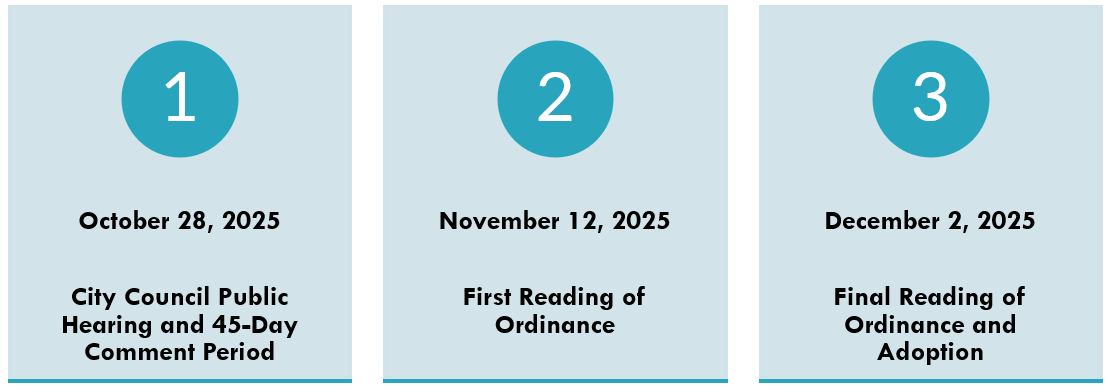
-
Tacoma Planning Commission Finalizes Recommendation for Council Consideration
On July 16, 2025, the Tacoma Planning Commission completed its review and recommendations regarding the Tideflats Subarea Plan and related amendments to the Land Use Regulatory Code. The Commission’s recommendations are included below and were presented to the City Council at a study session on August 12, 2025.
Draft Tideflats Subarea Plan Chapters
On December 5, 2024, the Tideflats Steering Committee, comprised of elected representatives from the City of Tacoma, Puyallup Tribe of Indians, Port of Tacoma, Pierce County, and the City of Fife, unanimously voted to recommend a Draft Tideflats Subarea Plan for adoption by the City of Tacoma.
- Letter of Recommendation
- Tideflats Subarea Plan (As recommended by the Steering Committee, Dec. 5, 2024)
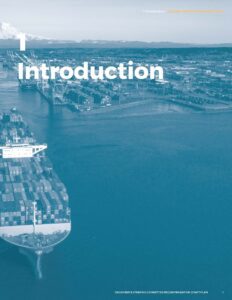
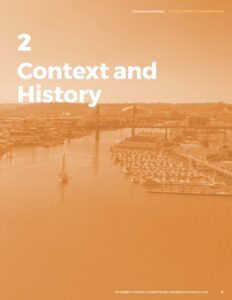
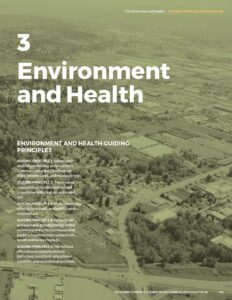
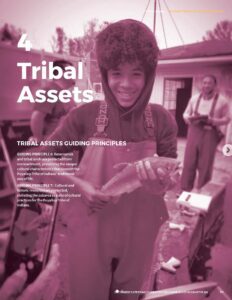
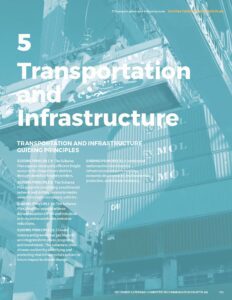
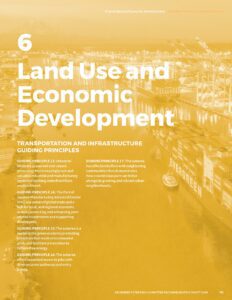
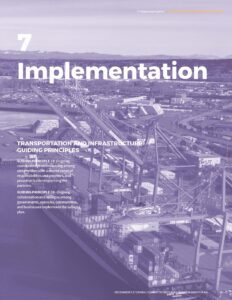
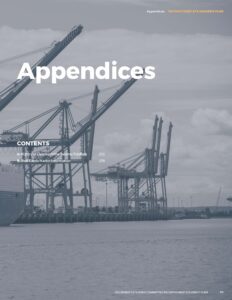
Stakeholder Groups
-
Tideflats Steering Committee
-
Introduction
The Tideflats Steering Committee consists of two elected leaders from each of the participating governments as outlined in the Intergovernmental Agreement. The governments that are members of the Steering Committee include the City of Tacoma, the City of Fife, the Puyallup Tribe of Indians, the Port of Tacoma, and Pierce County. The Tideflats subarea planning process will include regular consultation and information sharing with the Steering Committee, and the Steering Committee will be responsible for developing an initial draft Subarea Plan for consideration by the Tacoma Planning Commission and the City Council.
The Steering Committee is comprised of the following membership:
- Victoria Woodards, Mayor, City of Tacoma
- Kristina Walker, Council Member, City of Tacoma
- Bill Sterud, Chair, Puyallup Tribe of Indians
- Annette Bryan, Councilmember, Puyallup Tribe of Indians
- Dick Marzano, Commissioner, Port of Tacoma
- Deanna Keller, Commission President, Port of Tacoma
- Bruce Dammeier, County Executive, Pierce County
- Ryan Mello, Council Chair, Pierce County
- Kim Roscoe, Mayor, City of Fife
- Bryan Yambe, Council Member, City of Fife
-
Tideflats Advisory Group
-
Introduction
The Tideflats Advisory Group (TAG) will act as a “sounding board” for policy discussions, providing support to the Steering Committee and City of Tacoma during their respective parts of the process. In addition to its role as a sounding board, the TAG members will serve as liaisons to the broader stakeholder groups they represent.
The TAG is intended to reflect a broad and diverse representation of interests and perspectives on the future development of the Tideflats area. The composition of the TAG was agreed to by the Steering Committee in the Work Plan.
TAG meetings will be open to the public.
Tideflats Advisory Group Membership
-
Updates and Milestones
-
Steering Committee Adopts Draft Tideflats Subarea Plan
On December 5, 2024, the Tideflats Steering Committee, comprised of elected representatives from the City of Tacoma, Puyallup Tribe of Indians, Port of Tacoma, Pierce County, and the City of Fife, unanimously voted to recommend a Draft Tideflats Subarea Plan for adoption by the City of Tacoma.
The Steering Committee’s recommendation will be transmitted to the City Council and Tacoma Planning Commission. The Planning Commission will conduct a public hearing and comment period in early 2025 and is expected to provide their recommendations to the City Council in Spring 2025, followed by City Council consideration and possible adoption in Summer 2025.
Draft Tideflats Subarea Plan
Draft Letter of RecommendationThe Tideflats Subarea Plan is a unique and innovative plan. It creates a shared vision among five governments that balances industrial growth with environmental protection, community needs, and the long-term resilience of the region. It is a model for future planning in industrial areas that can inspire other areas facing similar challenges.
Specific aspects include:
- Balancing Industrial Success with Environmental Restoration: Plan policies called for coordinated actions and investments to restore ecosystems, improve water quality, and protect biodiversity alongside industrial development.
- Indigenous Values: The Plan honors both the natural and cultural landscapes of the region. Policies and action recognize the Puyallup Tribe’s rights and interests in the Tideflats and ensure that any development respects their cultural, economic, and environmental connections to the land.
- Comprehensive Climate Action: The Plan’s policies integrate climate resilience strategies, with specific actions around decarbonization goals, adaptive measures for sea-level rise, and restoration of natural habitats.
- Economic and Industrial Adaptation: The Plan supports economic flexibility by preserving core industrial uses and encouraging industries that meet environmental goals and facilitate innovation in clean energy. It demonstrates how a world class Port can thrive alongside growing urban neighborhoods.
- Transportation and Infrastructure Innovations: The Plan takes a holistic approach to transportation infrastructure, promoting proactive investments in multimodal transportation systems that support both the industrial sector and the surrounding community. It also incorporates green infrastructure solutions to mitigate pollution and improve the urban landscape as well as public access to the waterfront.
- Collaboration and Stakeholder Engagement: The Plan was developed through a seven-year long collaborative process that set up ongoing dialogue among local governments, tribes, businesses, and residents, fostering shared accountability and coordinated problem-solving for long-term implementation.
Community Informational Meeting Held on June 6, 2022
Thank you to everyone who attended the informational meeting on June 6, 2022, to learn about the Tideflats Subarea Plan and the upcoming SEPA Scoping Process. If you were unable to attend, you can review the presentation or watch the recording here:
Steering Committee
On March 24, 2022 the Steering Committee recommended Preliminary Alternatives for the EIS Scoping phase of the process.
Steering Committee
On August 12, 2021 the Steering Committee reviewed the consultant report summary of key findings from the Community Visioning Process.
Steering Committee and Tideflats Advisory Group
On March 11, 2021 the Steering Committee met jointly with the Tideflats Advisory Group to review and provide feedback on the draft Baseline Conditions Report.
Steering Committee
On July 9, 2020 the Steering Committee approved the Public Engagement Plan for the Subarea planning process.
Steering Committee
As a follow-up to the July 9 Steering Committee meeting, the intergovernmental Staff Leadership Team has provided the following briefing memo in lieu of a meeting on August 13, 2020. The memo is in response to the Steering Committee’s request to explore options to expedite the review and replacement of the Tideflats Interim Regulations.
Staff Briefing Memo (July 31, 2020)
Steering Committee meeting May 14, 2020
The Tideflats Steering Committee met to discuss project impacts resulting from COVID-19.
Planning Commission meeting March 4, 2020
The Planning Commission provided input on engagement goals and strategies on March 4, 2020.
Tideflats Advisory Group meeting February 20, 2020
The Tideflats Advisory Group met on February 20, 2020 to begin discussions to develop a public engagement plan for the Tideflats process.
Steering Committee meeting Nov. 7, 2019
The Steering Committee met to review and recommend a consultant for the Tideflats Subarea Plan. The recommendation is provided to the Tacoma City Council.
February 8, 2019
The Tideflats Subarea Plan Steering Committee approved the following Work Plan and supporting documents:
September 25, 2018
On September 25, 2018, the City Council adopted a resolution approving the City of Tacoma to enter into an Intergovernmental Agreement concerning cost sharing for the Tideflats Subarea Plan. The resolution also directed the City Manager to work with the indicated partners to develop a mutually satisfactory subarea planning and approval process no later than 60 days after the agreement is signed by all indicated parties.
November 21, 2017:
The City Council adopted Ordinance No. 28470 Tideflats Interim Regulations for an initial one-year period. To learn more, visit the Interim Regulations web page.
May 9, 2017:
The Tacoma City Council adopted Resolution No. 39723 initiating a subarea planning process for the Port of Tacoma/Tideflats.
-
Past Event Recordings
-
Community Visioning Report Out
Listen to the Community Visioning Report Out below or review our summary of the Visioning Process here: Community Visioning Engagement Summary.
Online Survey and Community Visioning Sessions
As an early step in the planning process, we wanted to hear your thoughts on what kind of future you want to see in the Tideflats. We hosted an online survey in the Spring 2021.
We also held three educational vision sessions on March 17, 18 and 20, 2021. Thank you to everyone who attended these virtual community events. You can watch the recordings under the Visioning Session below.
Visioning Session: Land Use & Economic Development
Wednesday, March 17, 2021 from noon to 1 PM
Visioning Session: Environment & Health
Thursday, March 18 from 6-7 p.m.
Visioning Session: Transportation and Infrastructure
Saturday, March 20 from noon to 1 p.m.
Tideflats Kick-Off Meeting
English Version
Spanish Version
Resource Library
-
Environmental Impact Statement
-
Tideflats Subarea Plan – Final Environmental Impact Statement
The Final Environmental Impact Statement is now available.
- Tideflats Final EIS Notice of Availability
- Tideflats Final EIS – Full Document
- Tideflats Final EIS – Appendices
Public Comment Period Closed – Tideflats Subarea Plan Draft Environmental Impact Statement
The Public Comment period for the Draft Environmental Impact Statement closed on May 23, 2024. Thank you to everyone who provided comments at this time. Response to public comments will be incorporated into the Final Environmental Impact Statement. Additional public comment opportunities will be forthcoming for the Draft Subarea Plan. Below are links to the Tideflats DEIS documents:
Determination of Significance
The City of Tacoma has determined that the Tacoma Tideflats Subarea Plan is likely to have a significant adverse environmental impact. An EIS under RCW 43.21C.030(2) (c) will be prepared.
Scoping and Alternatives
On October 18, 2022, the City Council affirmed the Steering Committee’s recommended Alternatives as the basis for the Plan and EIS. The Alternatives include a No Action Alternative and three Action Alternatives. It is anticipated that the alternatives will be based on variations of elements such as the mix of industrial zoning and land uses, employment growth scenarios, transition areas, housing types and location, sea level rise adaptation strategies, fish and wildlife habitat restoration, and shoreline public access and recreation.
For purposes of the No Action Alternative, it is assumed that development would occur within the Tacoma Tideflats Subarea based on existing zoning and development standards. Development or redevelopment that is proposed within the Tacoma Tideflats Subarea in conjunction with the No Action Alternative would undergo environmental review on a project-by-project basis. Such projects would be subject to site-specific mitigation and potential SEPA-based appeals.
-
Health Impact Assessment
-
Health Impact Assessments (HIA) inform decision-makers and the public of the potential health outcomes—both beneficial and harmful—of a proposed project, policy, or program. HIAs provide recommendations to increase potential public health benefits and reduce potential harms to public health. The City commissioned this HIA to provide a tool to evaluate the health impacts of the Tideflats Subarea Plan.
The Tacoma Pierce-County Health Department reviewed the Tideflats Subarea Plan’s proposed priority action items, transportation investments, and land use zoning map and code, and assessed how they might improve or harm public health in terms of air quality and water quality. In their recommendations, the Health Department:
- Created a tiered prioritization for the Plan’s action items and transportation investments.
- Identified land use code changes proposed in the Plan that could promote improvements in public health.
- Suggested amendments to the land use code and zoning map, including additional special use standards, performance measures, and prohibitions that could further promote improvements in public health.
Read the HIA here: https://tpchd.org/wp-content/uploads/2025/08/Tideflats-HIA-Report-August-2025.pdf
Staff Contact: Erin Dilworth, edilworth@tpchd.org
-
Tideflats Subarea Plan Documents
-
- Plan and EIS Alternatives
- Baseline Conditions Report
- Community Visioning Report
- Public Engagement Plan
- Shoreline Public Access Issue Paper
- Brownfields and Remediation Issue Paper
- Sea Level Rise Issue Paper
- Environment, Health, & Tribal Assets
- Economic Development Issue Paper
- Land Use Worksheets
- Land Use and Zoning Concept
- TSP – Work Plan
- TSP – Plan Process
- TSP – Budget
- TSP – Milestones
-
Additional Relevant Materials
-
Applicable State Policies
- Growth Management Act
- Container Port Element
- Shoreline Management Act
- Port Districts
- State Environmental Policy Act
Regional Plans and Plan Updates
- VISION 2040
- VISION 2050
- Transportation 2040
- Regional Transportation Plan Update
- Regional Economic Strategy
- Countywide Planning Policies
One Tacoma Plan
- One Tacoma Plan Elements
- How the Plan is Implemented
- One Tacoma Plan Tutorial
- One Tacoma Plan Interactive Map
Port of Tacoma Plans and Strategies
- Port of Tacoma Comprehensive Scheme of Harbor Improvements
- Port of Tacoma Strategic Plan
- Port of Tacoma Land Use and Transportation Plan
- Economic Impacts Analysis
Land Use
- Shoreline Master Program
- Tacoma Waterfront Lands Analysis (2008)
- Water-dependent Uses and Water Depth (2009)
Economic Studies
Transportation and Emergency Response
- Tideflats Emergency Response Plan
- Tideflats ITS Strategic Plan
- Tideflats ITS Engineering and Implementation Plan (DRAFT)
- Tideflats Area Transportation Study
- East Thea Foss Corridor Study
- Transportation Master Plan
Environment
- Environmental Action Plan
- Climate Resilience Study
- Shoreline Restoration Plan
- Shoreline Inventory and Characterization Report
- Sea Level Rise Projections and Report
- Northwest Ports Clean Air Strategy
Public Access and Recreation
Tideflats: Sub Area Planning Promo
Environmental, Cultural and Economic Importance
The Tideflats is a unique environment containing shoreline, river deltas, tidal creeks, freshwater and salt marshes, naturalized creeks, and river channel corridors.
With an area of over 5,000 acres of waterfront land providing vital saltwater and estuarian habitat for salmon, shellfish and other marine life, the Tideflats is an economic center that includes industrial and manufacturing and maritime activity in a world class port and is the ancestral lands of the Puyallup Tribe of Indians.
The area is also designated as the Port of Tacoma Manufacturing Industrial Center (MIC). The MIC is home to Tacoma and Pierce County’s highest concentration of industrial and manufacturing activity and is the work site for about 9,800 employees.
In recognition of the regional significance of the MIC, the City of Tacoma, Port of Tacoma, Puyallup Tribe of Indians, City of Fife, and Pierce County have partnered to develop a Tideflats Subarea Plan for adoption by the City of Tacoma as part of the City’s Comprehensive Plan.
